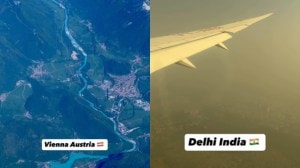Keira Knightley is my Phuljari
She was once the goddess in Raja Ravi Varma colours,selling Lakshmi Crackers to the devout at Diwali; or the buxom Bharatiya nari,demure even on a box of Cock-brand sparklers.
The cracker girl has changed,and a tradition is on its way out
She was once the goddess in Raja Ravi Varma colours,selling Lakshmi Crackers to the devout at Diwali; or the buxom Bharatiya nari,demure even on a box of Cock-brand sparklers. You can rarely spot her now,this muse of unnamed Indian firecracker artists. At shops in old Delhi’s Chandni Chowk,we spot the global pataka girl instead.
Here,size-zero Kareena Kapoor is the face that sells a thousand sparklers,and Aishwarya Rai Bachchan seems to have been nudged out of the competition. Katrina Kaif look-alikes peddle Italian Red fireworks; and white Hot Girls of indeterminate origin draw the wayward eye away from Celina Jaitley’s navel on another box of Texas Rider fireworks. But wait,how have Keira Knightley and the cast of Pride and Prejudice,clad in Victorian white,found themselves on the box of Shri Durkesh Fireworks’ Crystal Show? The answer,as to everything in this new age,is technology. Earlier the cracker boxes depicted south Indian actresses,but they have now moved towards more easily identifiable,popular icons. Today’s younger generation is more familiar with Hollywood actresses,and so they now appear on the boxes, says Siddhartha Tagore,writer and owner of Art and Deal magazine.
The gallery of pataka girls was once as homegrown as the rangoli in your home. They were hand-painted and printed in Sivakasi,which was the hub of both fireworks and the printing presses that produced much of the kitschy iconography that is associated with Indian pop culture calendar,firecracker and matchbox art. The images changed with time,with goddesses being replaced by film actresses and then with Bollywood bombs in Western wear,from Hema Malini to Zeenat Aman. The logical starting point for fireworks packaging was images from Hindu mythology,specifically from the Ramayana and Mahabharata; so there were images of Ganesha and Lakshmi on the boxes. These gave way to posters of pin-up girls and film actresses an all-enveloping feast for the senses. The icons were often generated directly from religious imagery that was popularised by Ravi Varma. It takes off from there and has come full-circle with Bollywood, says gallery owner Peter Nagy,who wrote the forward to Cock: Indian Firework Art (2001),a UK publication on firecracker art. (Behind the book is a story. In the late 1990s,Tom Singh,a UK-based Sikh,came to Old Delhi and bought an entire stall of fireworks,and then brought out a coffee table book on them. The crude,crass,crazy sales promotion of these images has been working its magic for years. We bought all the boxes and made people happy with the images in monochrome England, writes Gavin Aldred,who along with Singh brought out the book.)
At Chandni Chowk,we get lucky,as shop-owner Ankur Mathur brings out boxes of Meena Kumari rockets. These are clearly different from the images of white women that have proliferated,cut and pasted without a thought,across cultures and countries. The cracker girl on the box could be a 1960s Bollywood star,her Western allure signalled by her capri pants and the jaunty pill-box hat that she wears. The image is one that actors like Sadhana,Asha Parekh,Saira Banu and Babita made popular. It is really a miracle that this image has survived, says Mathur,holding aloft the slightly primitive looking single flair rocket. The older images of southern stars with flowers braided in long hair and mangalsutra on their necks,have been relegated to more down-market products like exploding sulphate pills and rope bombs.
The handmade images are on their way out even in Sivakasi as Photoshop and digital technology has made it easy to pick and paste images. Like the cinema hoardings,hand-painted labels are also a dying art, says photographer Ram Rahman. There has been a shift from artisan-oriented images that have a local quality to those that are freely available on the internet,have international appeal and are worked on in Photoshop. But digital media reduces everything to a standard look,these new images no longer reflect a specific location or culture, he adds.
Open the Kareena Kapoor box of sparklers,and you see again how images have travelled the world. Inside are six little individual boxes with images of Milla Jovovich,Jennifer Aniston,Lucy Lui and other foreign starlets.
They probably don’t know it,but they are the new cracker girls.



- 01
- 02
- 03
- 04
- 05




























